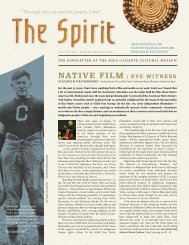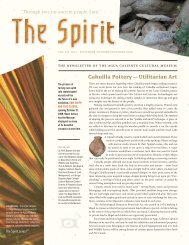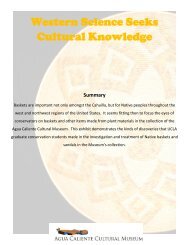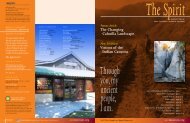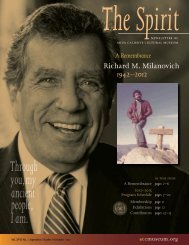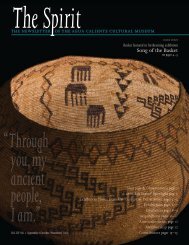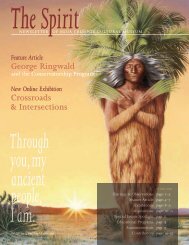You also want an ePaper? Increase the reach of your titles
YUMPU automatically turns print PDFs into web optimized ePapers that Google loves.
Abstract<br />
Both the <strong>Agua</strong> <strong>Caliente</strong> Band and the City of Palm <strong>Spring</strong>s derive their names from the famous<br />
<strong>Agua</strong> <strong>Caliente</strong> <strong>Hot</strong> <strong>Spring</strong>. Cahuilla oral literature tells of the <strong>Spring</strong>'s creation in the beginning<br />
by a powerful elder who created it as a perpetually-enduring place to heal.
Introduction<br />
Both the <strong>Agua</strong> <strong>Caliente</strong> Band and the City of Palm <strong>Spring</strong>s derive their names<br />
from the famous <strong>Agua</strong> <strong>Caliente</strong> <strong>Hot</strong> <strong>Spring</strong>. Cahuilla oral literature tells of the<br />
<strong>Spring</strong>'s creation in the beginning by a powerful elder who created it as a<br />
perpetually-enduring place to heal.<br />
According to Stories & Legends of the Palm <strong>Spring</strong>s Indians by Francisco<br />
Patencio, the first Cahuilla Indians to live in the area dared not live near the <strong>Hot</strong><br />
<strong>Spring</strong> because they were afraid of it. In the same way a stranger is treated with a<br />
cautious sense of distance, the <strong>Hot</strong> <strong>Spring</strong> was considered a sentient and unfamiliar<br />
entity. The Kauisik community’s eventual settlement at the <strong>Hot</strong> <strong>Spring</strong> happened<br />
only gradually.<br />
Although the people came to bathe in its warm mineral waters, the <strong>Hot</strong><br />
<strong>Spring</strong> was treated with the respect of a living being. If its waters were to be<br />
“A giant frog, blue in color, lived in the spring,<br />
with eyes big as a bull’s, a body over a foot<br />
across, and weighing something near a<br />
hundred pounds.” - Francisco Patencio, Stories<br />
& Legends of the Palm <strong>Spring</strong>s Indians, 1943<br />
utilized or disturbed in any way, food and prayers were offered to the <strong>Hot</strong> <strong>Spring</strong> within the kishumna’a, or ceremonial<br />
house. By doing so, the <strong>Hot</strong> <strong>Spring</strong> could be made use of without any harm happening to community members.<br />
Bathing in the <strong>Hot</strong> <strong>Spring</strong> eventually played a central feature in traditional life. As instructed by Menil, the<br />
Cahuilla Moon Maiden, bathing once in the morning and once towards evening was practiced. Hygiene was particularly<br />
important to hunters. The absence of a hunter’s scent would allow them to get closer to their prey without being<br />
detected. The <strong>Hot</strong> <strong>Spring</strong>’s palatable waters were also important for irrigation and consumption.<br />
Mirroring the interconnected nature of Cahuilla communities reliant on one another for the reciprocal exchange<br />
of food and other goods, hot springs throughout the region were believed to be connected underground. The discovery<br />
of rotted ears of green corn found in the <strong>Spring</strong> — crops planted in other locations where hot springs existed —<br />
represented hard proof of this. Cahuilla shamans, such as Pedro Chino, likewise utilized these subterranean channels in<br />
order to consult with the nukatem, or sacred beings, dwelling there. The knowledge they obtained would be utilized to<br />
cure the sick.
Strangers at the <strong>Hot</strong> <strong>Spring</strong><br />
A Cahuilla community located adjacent to a <strong>Hot</strong> <strong>Spring</strong> was vividly<br />
described by land surveyors in 1853 while exploring the region in<br />
preparation for the construction of the Southern Pacific Railroad:<br />
“After traveling about seven and a half miles over these long and<br />
barren slopes, we saw a green spot in the distance, and soon came<br />
to two large springs of water rising in the bare plain, not far from<br />
the foot of the mountains.”<br />
“One of these springs is warm, and forms a pool nearly thirty feet in<br />
diameter, and three to four feet deep. The cold spring is not quite so large, and is only ten feet distant from the<br />
other.”<br />
Executed during the William Blake survey’s journey<br />
through the Coachella Valley in 1853, this etching<br />
presumably depicts the <strong>Agua</strong> <strong>Caliente</strong> <strong>Hot</strong> <strong>Spring</strong> in its<br />
original state<br />
“This place was evidently a favorite camping-ground for Indians. When we arrived, many Indian boys and girls<br />
were bathing in the warm spring, and a group of [women] were engaged in cooking a meal...”<br />
Among the <strong>Hot</strong> <strong>Spring</strong>’s powerful properties were its curative waters -- a trait that quickly became known to the<br />
outside world. Stagecoaches, followed by the Southern Pacific Railroad, began bringing tourists to the <strong>Hot</strong> <strong>Spring</strong> where<br />
they might be cured of their ailments.<br />
Due to its rising popularity, the <strong>Hot</strong> <strong>Spring</strong> and its surrounding tribal land were leased to settlers in the late<br />
1880s. A rustic bathhouse was constructed on the site. Palm <strong>Spring</strong>s, and the tourist trade that survives today, was born.
<strong>Agua</strong> <strong>Caliente</strong> <strong>Hot</strong> <strong>Spring</strong> <strong>101</strong><br />
Evidence suggests that precipitation on the San Jacinto<br />
mountain range, seeping into a fractured, granitic basement complex,<br />
is the source of the <strong>Agua</strong> <strong>Caliente</strong> <strong>Hot</strong> <strong>Spring</strong>’s waters. The <strong>Hot</strong> <strong>Spring</strong><br />
may also be associated with seismic faulting, as its orifice has been<br />
known to change locations following earthquakes.<br />
Uniquely situated in the heart of the <strong>Agua</strong> <strong>Caliente</strong> Indian<br />
Reservation on a square mile called Section 14, the <strong>Hot</strong> <strong>Spring</strong> was<br />
known as Sec-he (“boiling water”) to Cahuilla-speaking people and as<br />
<strong>Agua</strong> <strong>Caliente</strong> (“hot water”) to early Spanish-speaking expeditions to<br />
the area. Today it is located underground near the corner of Tahquitz<br />
Canyon Way and Indian Canyon Drive – its waters collected and<br />
diverted to a spa facility in the same location. The <strong>Hot</strong> <strong>Spring</strong>'s waters remain popular.<br />
Generalized sketch showing possible relation of the <strong>Agua</strong><br />
<strong>Caliente</strong> <strong>Hot</strong> <strong>Spring</strong> to geological surroundings
Den of the Nukatem<br />
The existence of the <strong>Agua</strong> <strong>Caliente</strong> <strong>Hot</strong> <strong>Spring</strong> is explained in a<br />
Cahuilla migration legend. This legend was later retold by elder Francisco<br />
Patencio:<br />
“The head man, Tu-to-meet, was tired and sick and lame, so he took<br />
his whó-ya-no-hut (staff of power), which he struck in the ground.<br />
He twisted it around, and caused the water of a spring to come out<br />
– now Palm <strong>Spring</strong>s <strong>Hot</strong> <strong>Spring</strong>. He named it Sec he, meaning boiling<br />
water, which is up to the earth and on the earth, which is to be for<br />
ever, never to dry up, never to go away, but to be there for ever and<br />
always for the sick.”<br />
As evidenced by the story of Tu-to-meet and the creation of Sec he,<br />
the <strong>Hot</strong> <strong>Spring</strong>’s importance was not limited to its physical gifts. The <strong>Spring</strong><br />
represented an intermediary meeting point between the physical world and<br />
a supernatural underworld imbued with i’va’a (power) – the basic<br />
Francisco Patencio as depicted by artist Paul Grimm<br />
generative force from which all things were created. Beneath the waters was a subterranean world populated by<br />
powerful sacred beings called nukatem, remnants from the beginning of time with the ability to accomplish both good<br />
and evil. Nukatem were formed by Cahuilla creators Mukat and Temayawet. Most nukatem are no longer on earth, but<br />
some did not leave and remain active participants in this world.
Wahaatukicnikic (Blue Frog)<br />
Once a medicine man was sick and wanted to cure himself,<br />
praying for three days and nights without eating or drinking. On the<br />
last night, the manner in which he might be cured was revealed in a<br />
dream. To do so, he must enter the <strong>Hot</strong> <strong>Spring</strong> and visit the nukatem<br />
dwelling there.<br />
Entering into a den-like room, the medicine man encountered<br />
a Blue Frog, a Snake, another (Red Racer) snake, a Bear, a Lion, and<br />
an Albino Child.<br />
Addressing the Blue Frog, he asked how he might be cured.<br />
The frog redirected the man to the Snake. Asking the Snake the same<br />
question, the Snake coiled itself around his body and sent him on to<br />
Painting by Amil Pedro<br />
the Red Racer. The Red Racer did the same, sending him to the Bear and then to the Lion. Finally, the Lion sent him on to<br />
the Child, the chief power among the group.<br />
“Now the child had taken the form of an old man, and was sitting smoking a pipe. The medicine man went in and<br />
lay down before him. He told him he was sick and had come to be cured. But the old man was looking away, and<br />
did not look or speak to him.”<br />
“So the medicine man said again, ‘I am sick, and came down to be cured.’ Then he rose and reached for the old<br />
man’s pipe, which the old man handed to him quickly.”<br />
“The medicine man swallowed the smoke three times. Then the old man snatched it away. The medicine man<br />
then felt more power and knew that he was cured.”<br />
- Francisco Patencio, Stories & Legends of the Palm <strong>Spring</strong>s Indians, 1943
Sukat Tevishnekish (Magical White Deer)<br />
Another spiritual being residing in the <strong>Hot</strong> <strong>Spring</strong> waters is a Magical<br />
Deer that is said to be completely white in color.<br />
Pedro Chino, one of the most powerful type of Cahuilla shamans,<br />
was known to visit the Magical Deer beneath the <strong>Spring</strong>’s surface. Here, in a<br />
place he described as “not really water *but+ dry land underneath,” Pedro<br />
Chino was instructed by the Deer and other sacred beings on how to cure<br />
his people. “The beings living in the water show me,” he once said.<br />
“Before the white man came, the Deer would appear at the hot<br />
springs. There would be a storm. The medicine men would spring<br />
Painting by Amil Pedro<br />
upon the back of the deer and ride the lightning to the Upper Regions, where they found herbs and medicine for<br />
our people.”<br />
- Fannie Siva<br />
“Sukat tevishnekish pe pe. Yen pe pe panga hiwqa.” Translation: “That is the so called White Deer. But it lives in<br />
the water."<br />
- Katherine Siva Saubel, A Dried Coyote’s Tail
Pa-aqniwetem (Water Babies)<br />
In Cahuilla culture, supernatural beings are considered to be<br />
capable of both good and evil. The <strong>Hot</strong> <strong>Spring</strong>, dwelling place of such<br />
nukatem, was both revered and feared for this reason. Cahuilla legends tell<br />
of strange sounds or voices emanating from the <strong>Spring</strong>, reinforcing a<br />
respectful and cautious relationship to the <strong>Hot</strong> <strong>Spring</strong> and its powerful<br />
inhabitants. These voices might be human or animal in nature.<br />
According to tribal elder Pedro Chino, the <strong>Agua</strong> <strong>Caliente</strong> <strong>Hot</strong> <strong>Spring</strong><br />
was inhabited by Water Babies – precognitive nukatem that audibly cry, like<br />
human infants, when unfortunate events are about to take place. To hear<br />
the cry of a Water Baby, or to be called by one when nearing the water, is<br />
considered an ill omen that might mean death. Their cries are heard in the<br />
wee hours of the night.<br />
Painting by Amil Pedro<br />
"If you hear a baby cry, don’t go to find it – because it’ll pull you into the water, you know, and you’ll be<br />
drowned."<br />
- Donna Largo<br />
Though normally heard but not seen, Water Babies at times emerge from the <strong>Hot</strong> <strong>Spring</strong>. They are described as<br />
hairless, like newborn children. In one legend told by elder Francisco Patencio, Water Babies emerge from the <strong>Hot</strong><br />
<strong>Spring</strong> for the purpose of luring an unsuspecting victim into the waters, where they are drowned. These are nukatem to<br />
be feared.<br />
“One morning three of the sisters went to the <strong>Spring</strong>, and they saw a little child crying on the top of some fallen<br />
tule. But, instead of being dark skinned like an Indian, this child had pure white skin and hair.”<br />
“The younger sister went to it, thinking that it belonged to some of the people. But the other sisters told her to let<br />
it alone – that it was an animal, and not a child. But she would not listen, and she picked it up in her arms.”<br />
“Then a whirlwind came and lifted the girl and the child and whirled them up in the air. Then the whirlwind<br />
settled over the water, and both the girl and the child disappeared down with the water in[to] the <strong>Spring</strong>.”<br />
- Francisco Patencio, Stories & Legends of the Palm <strong>Spring</strong>s Indians, 1943
Bathhouse #1: Late 1880s<br />
Acknowledging of the popularity of the <strong>Hot</strong> <strong>Spring</strong> and its potential<br />
for building tribal revenues, tribal leaders in 1889 leased the <strong>Spring</strong> and the<br />
land surrounding it to settlers for three years in exchange for an annual<br />
rental of $150.00, land improvements, and use of the <strong>Hot</strong> <strong>Spring</strong> waters<br />
during non-business hours. A rustic bathhouse, described by James Smeaton<br />
Chase as a “rickety little hut,” was constructed on the site. The lease of the<br />
<strong>Spring</strong> was later renewed for a period of ten years.<br />
<strong>Agua</strong> <strong>Caliente</strong> bathhouse, late 1880s<br />
The leasing of the <strong>Hot</strong> <strong>Spring</strong> and other tribal assets were savvy business decisions that would prove to be<br />
valuable precedents for the general development of the tribe in the years to come. Land leasing, business development,<br />
and tourism laid the foundation for the City of Palm <strong>Spring</strong>s and continue to support the tribe to this day. Business<br />
decisions of this type were a continuation of the traditional role of Cahuilla leaders, which was to make economic<br />
decisions and utilize land to its best advantage on behalf of their communities. In traditional times, elders advised how<br />
to properly utilize an environment that was unpredictable and continually changing. Their ability to apply these<br />
traditional skills within the context of a new socio-economic reality would serve them well.
Bathhouse #2: Mid-1910s<br />
By the early 1910s, the original bathhouse had fallen into disrepair<br />
and was in need of improvements. Although the bathhouse enterprise was<br />
now owned and operated by the tribe, the federal government viewed<br />
tribal members as wards and collected money on their behalf. Ironically,<br />
federal red-tape prevented repair of the bathhouse due to the<br />
government’s inability to account for entrance fee money. Tribal leaders<br />
were aware of these missing funds because they had kept accounts.<br />
<strong>Agua</strong> <strong>Caliente</strong> bathhouse, circa 1910s<br />
Eventually the bathhouse was razed and a second one was constructed in the mid-1910s. This bathhouse,<br />
immediately recognizable thanks to its signature turret and “BATHS” sign, witnessed more instances of federal<br />
interference. Federal agents routinely questioned tribal use of bathhouse profits, including one $500.00 donation to the<br />
Mission Indian Federation: a pro-sovereignty Indian organization. Not understanding that economic decisions were the<br />
hereditary and sacred duty of tribal leaders, federal Indian agents routinely failed to understand Cahuilla leadership<br />
traditions during this period.
Bathhouse #3: 1930s<br />
The bathhouse was rebuilt again in the 1930s with funds obtained<br />
from a recent airport lease on Section 14. In its updated form, the<br />
bathhouse began drawing such Hollywood notables as Dolores Del Rio,<br />
Robert Taylor, Bruce Cabot, Ralph Belamy, and Charles Farrell; the stars in<br />
turn attracted the attention of the editor of the March of Time news<br />
movies, who sent a photographer to film the bathhouse. The <strong>Agua</strong> <strong>Caliente</strong><br />
<strong>Hot</strong> <strong>Spring</strong>, and the city which grew up around it, had become famous.<br />
Despite (or possibly due to) the financial success of the bathhouse,<br />
the 1930s marked an all-time low for tribal sovereignty. Having managed<br />
the bathhouse enterprise for more than thirty years, tribal leaders began<br />
making business decisions that were at odds with the non-Indian<br />
community, such as the raising of Indian Canyon and bathhouse entrance<br />
fees. Such decisions incensed non-Indian business owners who felt that<br />
<strong>Agua</strong> <strong>Caliente</strong> bathhouse, circa 1930s<br />
increased fees negatively impacted their own businesses; they demanded that federal authorities intervene to solve<br />
what they called “the Indian problem.”<br />
The federal government responded by taking control of the <strong>Agua</strong> <strong>Caliente</strong> Indian Reservation and its business<br />
enterprises and later arrested tribal leaders on November 20, 1937. Fees were forcibly reduced to their pre-1937 levels –<br />
temporarily.<br />
Tribal member Clemente Segundo traveled to Washington D.C. to expose these actions, which were later<br />
criticized as an over-stepping of federal authority. Addressing the House of Representative’s Committee on Indian<br />
Affairs, Clemente described a collusion of interests between federal officials and the Palm <strong>Spring</strong>s Chamber of<br />
Commerce that had given rise to these events. Control of the reservation was returned to tribe some time later.<br />
bathhouse.<br />
The third and final bathhouse was destroyed in 1957 to make way for the next incarnation of the tribal
Albert Santos Patencio: Keeper of the Bathhouse<br />
The three bathhouses which stood at the site of the <strong>Hot</strong> <strong>Spring</strong> were<br />
important tribal enterprises for the <strong>Agua</strong> <strong>Caliente</strong> Band. They provided<br />
much needed income during a period of limited economic opportunities.<br />
Groundskeepers were required to look after the daily operations of the<br />
baths, including the acceptance of entrance fees, limiting use time to 20<br />
minutes, and enforcing sanitary rules.<br />
Although there were many tribal members employed in this<br />
manner, Albert Santos Patencio remains one of the more memorable of the<br />
tribal members who filled this role. Albert lived during a transitional period<br />
in <strong>Agua</strong> <strong>Caliente</strong> life and was active in both tribal affairs and the non-Indian<br />
community.<br />
Palm <strong>Spring</strong>s at the turn of the century began to develop a robust<br />
tourist industry attracting health-seekers and invalids, thanks to the<br />
popularity and curative reputation of the <strong>Hot</strong> <strong>Spring</strong>. Following construction<br />
Albert Patencio<br />
Gift of Renona Pennington<br />
of the Desert Inn, one of the first non-Indian businesses catering to health-seekers, Albert became the new hotel’s first<br />
handyman. He routinely drove to the new Southern Pacific Railway station at Seven Palms to pick up hotel guests and to<br />
gather provisions. In tribal life Albert held the position of net, or ceremonial leader, between the years 1947-1951.<br />
In traditional times, the net was responsible for perpetuating the cultural laws and history of the Cahuilla<br />
people, codified by an intricate system of songs.
<strong>Hot</strong> Commodities<br />
The <strong>Agua</strong> <strong>Caliente</strong> <strong>Hot</strong> <strong>Spring</strong> is communally owned by the <strong>Agua</strong><br />
<strong>Caliente</strong> Band of Cahuilla Indians. Following presidential orders in 1876 and<br />
1877 that established the <strong>Agua</strong> <strong>Caliente</strong> Indian Reservation, the federal<br />
allotment policy divided up the Reservation into individual parcels owned by<br />
individual tribal members. Some portions of the reservation were excluded<br />
from allotment, however, so that they might benefit the tribe as a whole.<br />
The <strong>Hot</strong> <strong>Spring</strong> is one of them. This parcel of land, located in Section 14 just<br />
east of Indian Canyon Drive, is commonly referred to as the Mineral <strong>Spring</strong><br />
Parcel.<br />
Western Union Telegram showing the Palm <strong>Spring</strong>s<br />
Chamber of Commerce's interest in the <strong>Hot</strong> <strong>Spring</strong><br />
Parcel in the 1930s<br />
Following construction of the first bathhouse, the Mineral <strong>Spring</strong> Parcel was rendered a valuable piece of real<br />
estate due to its popularity and income-producing potential. For much of the past 150 years, many individuals and<br />
groups have attempted to gain control of the parcel and its valuable hot spring waters.<br />
• Indian Agent Lawson attended an 1881 Los Angeles trial of a non-Indian arrested for “malicious mischief” who had<br />
settled on Section 15 and then tore down fences on Section 14, taking over the <strong>Hot</strong> <strong>Spring</strong>. By the time he was found<br />
guilty and forbidden to return, another such man had taken his place.<br />
• In 1889, former Indian Agent J. G. McCallum traveled to Washington D.C. to secure rights to the <strong>Hot</strong> <strong>Spring</strong>. In years<br />
prior, McCallum in his official capacity had approved non-Indian claims to even-numbered reservation lands on a legal<br />
technicality, despite the fact he’d been employed to protect Cahuilla interests. His efforts to secure the <strong>Hot</strong> <strong>Spring</strong><br />
failed.<br />
• Following the lapse of the first 3-year lease in 1892, federal agents attempted to renew the lease at a reduced yearly<br />
rental price, against the wishes of tribal leaders. Tribal captain Jose Rafael responded with a letter of protest to federal<br />
officials and by taking back the keys to the bathhouse.<br />
• In response to the tribe’s refusal to renew the original 1889 lease in 1892, a federal agent roused tribal leaders from<br />
their sleep in the middle of the night and forced them to sign a document approving a ten year lease renewal which now<br />
included a five acre parcel of land surrounding it. This land contained mature fruit trees and farm land vital as tribal<br />
revenue sources. Tribal leaders protested that they had been duped and placed a padlock on the bathhouse door. The<br />
lease was re-written to exclude the additional land.
• Following seven years of tribal control of the bathhouse, the federal government took over its operation in 1909.<br />
Federal oversight continued until the 1930s. Not understanding traditional tribal modes of economic distribution and<br />
decision-making, the government felt it was resolving internal disagreements over profit usage.<br />
• Throughout the 1930s, the Palm <strong>Spring</strong>s Chamber of Commerce sought to gain control of the Mineral <strong>Spring</strong> Parcel<br />
and the Indian Canyons by means of National Monument designation. The Mineral <strong>Spring</strong>s Parcel was envisioned to be<br />
an administrative headquarters for National Park administration staff. These efforts ultimately failed.<br />
• In 1936, tribal leaders raised access fees to the bathhouse and the Indian Canyons. Non-Indian business owners,<br />
organized through the Palm <strong>Spring</strong>s Chamber of Commerce, viewed this as a threat to their tourism-based livelihood.<br />
Colluding with Chamber of Commerce business owners, the federal government assumed direct control over the<br />
Reservation and its tribal enterprises, including the bathhouse, on January 1, 1937.<br />
• The 1959 federal program of Equalization, the re-parceling of allotments due to their varying real estate values, also<br />
threatened to remove Mineral <strong>Spring</strong> Parcel’s reserve status when the Bureau of Indian Affairs, in favor of federal<br />
termination policies, proposed to allot the parcel to individuals. Indian termination was a policy that the United States<br />
Congress implemented in the 1950s and 1960s to terminate the government's trusteeship of Indian reservations. Tribal<br />
members successfully opposed these efforts so that the parcel would continue to benefit the tribe as a whole.
Primary Sources & Further Reading<br />
We suggest the following source materials for further research on the <strong>Agua</strong> <strong>Caliente</strong> <strong>Hot</strong> <strong>Spring</strong>. Materials are available<br />
at the <strong>Agua</strong> <strong>Caliente</strong> Cultural Museum library by appointment.<br />
Cultural Systems Research, Inc. 1995. Archaeological, Ethnographic, and Ethnohistoric Investigations at Tahquitz Canyon<br />
- Palm <strong>Spring</strong>s, California. Menlo Park<br />
Blake, William P. 1857. Explorations and Surveys for a Railroad from the Mississippi River to the Pacific Ocean.<br />
Washington D.C.<br />
Dutcher, Lee Carlton. 1963. Geology and Hyrdology of <strong>Agua</strong> <strong>Caliente</strong> <strong>Spring</strong>, Palm <strong>Spring</strong>s, California. United States<br />
Printing Office, Washington<br />
Patencio, Francisco. 1943. Stories and Legends of the Palm <strong>Spring</strong>s Indians. Times-Mirror Press, Los Angeles<br />
Saubel, Katherine Siva. 2004. A Dried Coyote's Tail ('Isill Heqwas Waxish). Bellena Press, Banning. ISBN 0939046407<br />
Shaw, Rachel Dayton. 1999. Evolving Ecoscape: An Environmental and Cultural History of Palm <strong>Spring</strong>s, California, and<br />
the <strong>Agua</strong> <strong>Caliente</strong> Indian Reservation, 1877-1939. University of California, San Diego. Dissertation.



